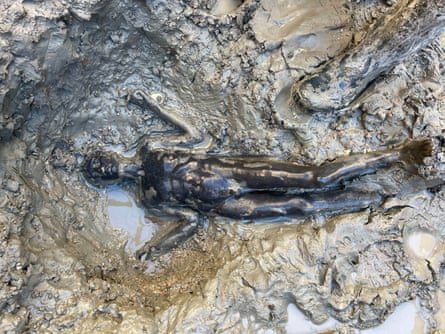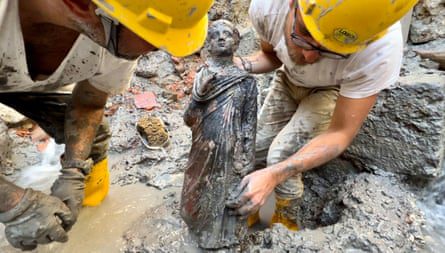An “exceptional” group of bronze statues preserved thousands of years ago in mud and boiling water was discovered in a network of baths built by the Etruscans in Tuscany.
The 24 partially submerged statues, dating back 2,300 years and hailed as the most important find of its kind in 50 years, include a sleeping Efebi lying next to Hygeia, the goddess of health, with a snake wrapped around her arm.
Archaeologists came across the statues during excavations at the ancient spa at San Cassiano di Bagni, near Siena. The modern spa, with 42 hot springs, is located near the ancient site and is one of Italy’s most popular tourist destinations.

Near Efebi (teenage male, usually 17-18 years old) and Hygeia was a statue of Apollo and a group of others representing shepherds, children, and emperors.
These baths are believed to have been constructed by the Etruscans in the 3rd century BC, and the baths, which include fountains and altars, became more luxurious during the Roman period, as emperors including Augustus frequented the springs for their health and therapeutic benefits.
Besides the 24 bronze statues, five of which are about a meter high, archaeologists have found thousands of coins as well as Etruscan and Latin inscriptions. It is said that visitors tossed coins into the baths as a sign of good fortune for their health.
Massimo Osana, director general of museums at the Italian Ministry of Culture, said the relics were the most important find of its kind since two full-size Greek bronzes of naked bearded warriors were found off the coast of Calabria near Riace in 1972. Ansa”, it is certainly one of the most important discoveries of bronze in the history of the ancient Mediterranean.

Archaeologist Jacopo Taboli has led the excavation project at San Casciano dei Bagni since 2019. In August, several artifacts, including fertility statues believed to have been used as gifts to the gods, were found at the site. Taboli, a professor at the University of Siena for Foreigners, called the latest discovery “absolutely unique”.
Etruscan civilization flourished in Italy, mostly in the central regions of Tuscany and Umbria, for 500 years before the arrival of the Roman Republic. The Etruscans had a strong influence on Roman cultural and artistic traditions.
Preliminary analysis of the twenty-four statues, believed to have been made by local craftsmen between the second and first centuries BC, as well as the countless votive offerings discovered at the site, indicates that the relics may have originally belonged to elite Etruscan and Roman families, landowners, Local lords and Roman emperors.

Taboli told Ansa that hot springs rich in minerals including calcium and magnesium remained active until the fifth century, before they were closed, but not destroyed, during the Christian era. Ponds were closed with heavy stone pillars while divine statues were left in the holy waters.
The treasure trove was found after archaeologists removed the cover. “It is the largest storehouse of statues from ancient Italy and the only one we can completely reconstruct its context,” Taboli said.
The newly appointed Italian Minister of Culture, Gennaro Sangiuliano, said the “extraordinary discovery” confirms once again that “Italy is a country full of huge and unique treasures”.
The ruins are an important testament to the transition between the Etruscan and Roman periods, with the baths considered a haven of peace.
“Even in historical times when the most terrible conflicts were taking place abroad, it seems that the two worlds, within these pools and on these altars, the two worlds, the Etruscan and the Roman, coexisted without problems,” said Tabule.
Excavations at the site will resume next spring, while the winter period will be used for restoration and further studies of the ruins.
The artifacts will be housed in a 16th-century building recently purchased by the Ministry of Culture in the town of San Cassiano, near Florence. The site of the ancient baths will also be developed into an archaeological park.
“All of this will be strengthened and coordinated, and could represent another opportunity for the spiritual growth of our culture, as well as for the cultural industry of our country,” Sangiuliano said.

“Travel specialist. Typical social media scholar. Friend of animals everywhere. Freelance zombie ninja. Twitter buff.”





More Stories
Macron rejects left-wing bid to appoint PM before Olympics
Dogs can smell human stress and make decisions accordingly, study says: NPR
Hamas and Fatah sign declaration to form future government as war rages in Gaza